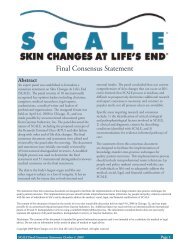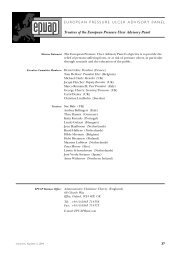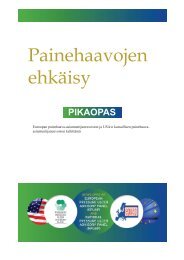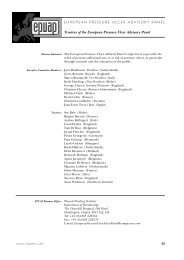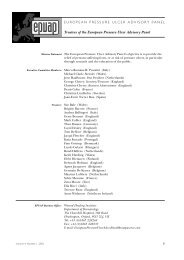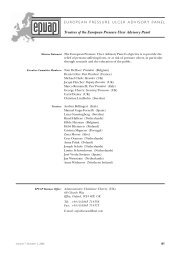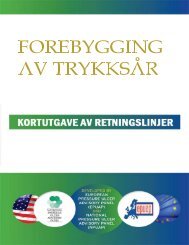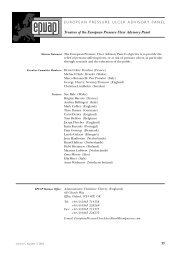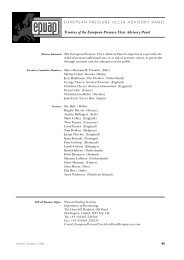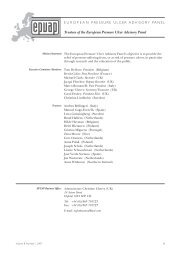EPUAP Review 10.1.indd - European Pressure Ulcer Advisory Panel
EPUAP Review 10.1.indd - European Pressure Ulcer Advisory Panel
EPUAP Review 10.1.indd - European Pressure Ulcer Advisory Panel
You also want an ePaper? Increase the reach of your titles
YUMPU automatically turns print PDFs into web optimized ePapers that Google loves.
epuap <strong>Pressure</strong><br />
E U R O P E A N P R E S S U R E U L C E R A D V I S O R Y PA N E L<br />
<strong>Ulcer</strong> Prevention<br />
QUICK REFERENCE GUIDE<br />
RISK ASSESSMENT<br />
RISK ASSESSMENT POLICY<br />
Epidemiological research has increased considerably in recent years,<br />
providing a better understanding of risk factors important in the development<br />
of pressure ulcers and this literature needs to underpin risk assessment<br />
practice. However, one must be careful with interpreting the results<br />
of these epidemiological research studies, as the results may depend on<br />
which risk factors are included in the multi-variable model.<br />
1. Establish a risk assessment policy in all health care settings. (Strength<br />
of Evidence = C)<br />
Each health care setting should have a policy in place including recommendations<br />
for the structured approach to risk assessment relevant to<br />
the health care setting, targeted clinical areas, the timing of risk assessment<br />
and reassessment, clear recommendations for documentation of<br />
risk assessment and communication to the wider healthcare team.<br />
2. Educate healthcare professionals on how to achieve an accurate and<br />
reliable risk assessment. (Strength of Evidence = B)<br />
3. Document all risk assessments. (Strength of Evidence = C)<br />
Documentation of risk assessments are required to ensure communication<br />
within the multidisciplinary team, confer evidence that care<br />
planning is appropriate and provide a benchmark to monitor the<br />
progress of the individual.<br />
RISK ASSESSMENT PRACTICE<br />
4. Use a structured approach to risk assessment to identify individuals at<br />
risk of pressure ulcer development. (Strength of Evidence = C)<br />
A structured approach may be achieved through the use of a risk assessment<br />
scale in conjunction with a comprehensive skin assessment and<br />
clinical judgment.<br />
Despite the fact there are some limitations of risk assessment scales,<br />
their widespread utilization would suggest this is indicative of the value<br />
professionals place on them. Evidence suggests that their introduction<br />
in conjunction with the establishment of skin care teams, education<br />
programs and care protocols may reduce the incidence of pressure<br />
ulcers. Better than clinical judgement<br />
5. Use a structured approach to risk assessment which includes assessment<br />
of activity and mobility. (Strength of evidence = C)<br />
5.1. Consider individuals who are bedfast and/or chairfast to be at<br />
risk of pressure ulcer development.<br />
6. Use a structured approach to risk assessment which includes a comprehensive<br />
skin assessment including alterations to intact skin. (Strength of<br />
evidence = C)<br />
Volume 10, Number 1, 2009 5



